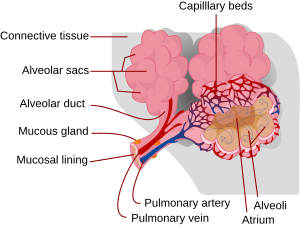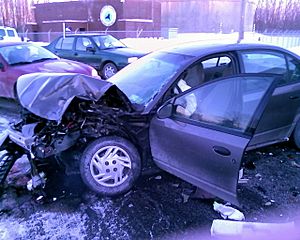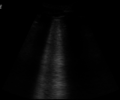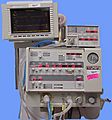Pulmonary contusion facts for kids
Quick facts for kids Pulmonary contusion or Lung contusion |
|
|---|---|
| Synonyms | Lung contusion |
 |
|
| A CT scan showing a pulmonary contusion (red arrow) accompanied by a rib fracture (blue arrow) | |
A pulmonary contusion, also known as a lung contusion or bruised lung, happens when your lung gets a bruise from a hard hit to the chest. This kind of injury damages the tiny blood vessels (called capillaries) inside your lung. When these vessels are hurt, blood and other liquids can leak out and collect in the lung.
These extra liquids make it harder for your lungs to do their job, which is to get oxygen into your blood. When your body doesn't get enough oxygen, it's called hypoxia. If the lung is cut instead of just bruised, it's called a pulmonary laceration, and that's a different kind of injury.
A bruised lung is usually caused by a strong impact, like from an accident. Explosions or powerful energy waves from an injury can also cause this problem.
Doctors started learning more about bruised lungs after soldiers were hurt by explosives in World War I and II. Later, in the 1960s, as more people drove cars, this injury became common from car accidents.
What Happens Inside Your Lung?

A bruised lung (contusion) and a cut lung (laceration) are both injuries to the lung. In a contusion, the lung's structure stays mostly the same, even though it's bruised. In a laceration, parts of the lung might be moved or torn.
When blood fills a cut in the lung, it's called a pulmonary hematoma. The main difference is that in a bruise, the tiny air sacs in your lungs, called alveoli, will bleed. A hematoma, however, is a blood clot that forms inside the lung.
Sometimes, blood (hemothorax) or air (pneumothorax) can collect in the space outside the lung, called the pleural cavity. If both blood and air collect there, it's called a hemopneumothorax. These conditions can cause a "collapsed lung." They might happen because of a lung injury, or they might cause damage to the lung themselves.
Injuries to the chest wall, like rib fractures, are different from lung injuries. However, they often happen at the same time. A serious chest wall injury is called flail chest, which means several ribs are broken and move separately from the rest of the rib cage.
How Do Lungs Get Bruised?
A bruised lung is the most common injury from a hard hit to the chest. It happens in about 25–35% of these cases. It usually occurs when someone is moving fast and then suddenly stops or hits something.
About 70% of bruised lung cases are from motor vehicle collisions. This often happens when a person's chest hits the inside of the car during a crash. Other causes include falls, fights, and sports injuries.
Explosions can also cause bruised lungs. The parts of the body most harmed by blast injuries are those that hold gas, like the lungs. A "blast lung" is a very serious bruised lung. It can involve bleeding, swelling (edema), and damage to the air sacs and blood vessels. This is often why people die after surviving an explosion at first. Unlike other injuries where a bruised lung often comes with other chest injuries, explosions can cause a bruised lung even if the chest wall looks fine.
Images for kids
-
A chest CT scan revealing pulmonary contusions, pneumothorax, and pseudocysts
-
An ultrasound image showing early pulmonary contusion, at this moment not visible on radiography. Lung swelling is seen as vertical white lines, the "B-lines".
-
Mechanical ventilation may be required if pulmonary contusion causes inadequate oxygenation.
-
A chest X-ray showing acute respiratory distress syndrome
-
Giovanni Battista Morgagni, credited with having first described lung trauma without chest wall trauma
See also
 In Spanish: Contusión pulmonar para niños
In Spanish: Contusión pulmonar para niños








